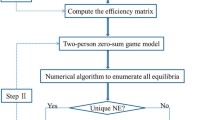Abstract
Conventional data envelopment analysis evaluates the relative efficiency of a set of homogeneous decision making units (DMUs), where DMUs are evaluated in terms of a specified set of inputs and outputs. In some situations, however, a performance factor could serve as either an output or an input. These factors are referred to as dual-role factors. The presence of dual-role factor among performance factors gives rise to the issue of how to fairly designate the input/output status to such factor. Several studies have been conducted treating a dual-role factor in both methodological and applied nature. One approach taken to address this problem is to view the dual-role factor as being nondiscretionary and connect it to the returns to scale concepts. It is argued that the idea of classifying a factor as an input or an output within a single model cannot consider the causality relationships between inputs and outputs. In this paper we present a mixed integer linear programming approach with the aim at dealing with the dual-role factor. Model structure is developed for finding the status of a dual-role factor via solving a single model while considering the causality relationships between inputs and outputs. It is shown that the new model can designate the status of a dual-role factor with half calculations as the previous model. Both individual and aggregate points of view are suggested for deriving the most appropriate designation of the dual-role factor. A data set involving 18 supplier selections is adapted from literature review to illustrate the efficacy of the proposed models and compare the new approach with the previous ones.
Similar content being viewed by others
References
Amirteimoori A, Emrouznejad A (2012) Notes on classifying inputs and outputs in data envelopment analysis. Appl Math Lett 25:1625–1628
Amirteimoori A, Emrouznejad A, Khoshandam L (2013) Classifying flexible measures in data envelopment analysis: a slack-based measure. Measurement 46:4100–4107
Banker RD, Charnes A, Cooper WW (1984) Some models for estimating thechnical and scale inefficiencies in data envelopment analysis. Manag Sci 30:1078–1092
Banker RD, Morey RC (1986) Efficiency analysis for exogenously fixed inputs and outputs. Oper Res 34:513–521
Beasley J (1990) Comparing university departments. Omega 8(2):171–183
Beasley J (1995) Determining teaching and research efficiences. J Oper Res Soc 46:441–452
Charnes A, Cooper WW, Rhodes E (1978) Measuring the efficiency of decision making units. Eur J Oper Res 2(6):428–444
Cook WD, Hababou M, Tuenter H (2000) Multicomponent efficiency measurement and shared inputs in data envelopment analysis: an application to sales and service performance in bank branches. J Product Anal 14(3):209–224
Cook WD, Hababou M (2001) Sales performance measurement in bank branches. Omega 29:299–307
Cook WD, Green RH, Zhu J (2006) Dual-role factors in data envelopment analysis. IIE Trans 38:105–115
Cook WD, Zhu J (2007) Classifying inputs and outputs in data envelopment analysis. Eur J Oper Res 180(2):692–699
Cooper WW, Seiford LM, Tone K (2007) Introduction to data envelopment analysis and its uses: with DEA-solver software and references, 2nd edn. Springer, New York
Ding J, Dong W, Bi G, Liang L (2015) A decision model for supplier selection in the presence of dual-role factors. J Oper Res Soc 66:737–746
Fazripoor Saen R (2010) A new model for selecting third-party reverse logistics providers in the presence of multiple dual-role factors. Int J Adv Manuf Technol 46(1–4):405–410
Grosskopf S, Margaritis D, Valdmanis V (2001) Comparing teaching and non-teaching hospitals: a frontier approach (teaching vs. non-teaching hospitals). Health Care Manag Sci 4(2):83–90
Hillier FS, Lieberman GJ (2001) Introduction to operations research, 7th edn. McGraw-Hill, New York
Mahdiloo M, Noorizadeh A, Farzipoor Saen R (2011) A new approach for considering a dual-role factor in supplier selection problem. Int J Acad Res 3(1):261–266
Mahdiloo M, Noorizadeh A, Farzipoor Saen R (2013) A new model for suppliers ranking in the presence of both dual-role factors and undesirable outputs. Int J Logist Syst Manag 15(1):93–107
Noorizadeh A, Mahdiloo M, Farzipoor Saen R (2012) A new approach for considering a dual-role factor in data envelopment analysis. Int J Oper Res 14:135–155
Taha HA (2007) Operations research: an introduction, 8th edn. Pearson Prentice Hall, Upper Saddle River
Talluri S, Baker RC (2002) A multi-phase mathematical programming approach for effective supply chain design. Eur J Oper Res 141(3):544–558
Toloo M (2009) On classifying inputs and outputs in DEA: a revised model. Eur J Oper Res 198:358–360
Toloo M (2012) Alternative solutions for classifying inputs and outputs in data envelopment analysis. Comput Math Appl 63:1104–1110
Toloo M (2014) Notes on classifying inputs and outputs in DEA: a comment. Eur J Oper Res 235:810–812
Toloo M, Barat M, Masoomzadeh A (2015) Selective measures in data envelopment analysis. Ann Oper Res 226:623–642
Toloo M, Tichy T (2015) Two alternative approaches for selecting performance measures in data envelopment analysis. Measurement 65:29–40
Acknowledgments
The research was supported by the Czech Science Foundation (GACR Project 14-31593S) and through European Social Fund within the Project CZ.1.07/2.3.00/20.0296.
Author information
Authors and Affiliations
Corresponding author
Rights and permissions
About this article
Cite this article
Toloo, M., Barat, M. On considering dual-role factor in supplier selection problem. Math Meth Oper Res 82, 107–122 (2015). https://doi.org/10.1007/s00186-015-0507-z
Received:
Accepted:
Published:
Issue Date:
DOI: https://doi.org/10.1007/s00186-015-0507-z




